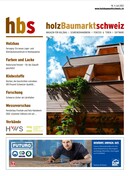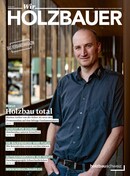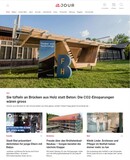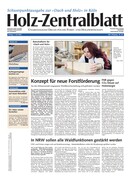Wood in infrastructure construction
Infrastructure construction is one of the largest CO₂ emitters in Switzerland. The main cause is the use of reinforced concrete. By increasing the use of wood, infrastructure construction could contribute to decarbonization. The first good examples have been built. However, there is still great potential for development.
As early as 1998, Stefan Zöllig showed in a basic report that wood, as a domestic raw material, is a cost is a cost-effective and ecological alternative for wildlife bridges. About 20 years later, we are building such structures in wood. Wood is also successfully used for noise barriers and other infrastructure structures. We are convinced that wood will be used as a standard in infrastructure construction.
Timbatec is involved in research projects and at the political level to ensure that wood is used more in infrastructure construction in the future. We believe that the political framework and new findings from research will bring a breakthrough for wood as a building material in infrastructure.
Motion "Research and Innovation of wood as a material for use in infrastructure construction as a decarbonization contribution".
The Council of States and the National Council have approved the motion "Research and innovation of wood as a material for use in infrastructure construction as a decarbonization contribution". The Federal Council is now tasked with universities and the relevant standardization commissions to investigate the possibilities for decarbonizing infrastructure construction. In particular, it is to be examined or sought to supplement or replace reinforced concrete with CO₂-storing materials. The research and innovation of wood as a material for widespread use in infrastructure construction is in the foreground.
Wood as a CO₂ store - also in infrastructure construction?
Concrete is by far the most frequently used building material. In Switzerland, we use around 40 million tons of it every year. This has a major impact on the climate. Cement production alone contributes over 5 percent of national CO₂ emissions, with annual CO₂ emissions of around 2.5 million tons.
Wood, on the other hand, is a CO₂ store. One cubic meter of wood relieves the atmosphere of about one ton of CO₂, because trees convert CO₂ into oxygen and carbon as they grow thanks to photosynthesis.
Each cubic meter of timber stores around one ton of CO₂. Wooden buildings thus become long-term CO₂ stores, because the CO₂ remains stored in the wood until it is burned or rots. Then exactly the same amount of CO₂ goes back into the air as was once stored when the wood grew. If the wood is reused, the CO₂ remains stored during another life cycle.
Research and implementation strategy with the Bern University of Applied Sciences
Together with the Bern University of Applied Sciences, Timbatec has developed a research and implementation strategy. In the process, we identified nine areas where wood could be increasingly used in the future. For the construction of infrastructures, in the building sector but also in other areas such as the road sector, various solutions are already available today with materials that do not produce CO₂ during manufacture but store it, such as wood. Wildlife overpasses, noise barriers or cross-axis bridges are already being built using wood.
For wood to once be used in tunnel construction projects and heavy-duty bridges, various research questions still need to be clarified. To this end, we are in close contact with the leading universities.
The research and implementation strategy of the Bern University of Applied Sciences, on the possible areas where in the future wood can be used and thus substitute steel and concrete. The resulting amount of CO₂ saved makes a significant contribution to climate protection.
Will we be building bridges for 40-ton trucks out of wood in the future?
A great potential for the use of wood in infrastructure construction lies in the bridge sector, especially for bridges over highways. Switzerland's nearly 2255-kilometer-long national road network includes 4270 bridges - that's about two bridges per kilometer of road. Most of these are made of steel and concrete. Wood, on the other hand, currently makes up only about three percent of the load-bearing structure. Yet this versatile material has great potential, including for the construction of bridges for heavy loads such as 40-ton trucks.
Would you like to load this additional content?
This placeholder hides an external resource that has not been loaded due to your cookie settings. Click on the button below to allow this resource.
Researchers from the Institute of Timber Construction, Structures and Architecture IHTA at the Bern University of Applied Sciences BFH are working together with partners from industry on a feasibility study on how heavy-duty bridges can be built with wood as standard in the future. Timbatec is strongly involved in this project, because we are convinced that such bridges can soon be realized.
Working model of the feasibility study
The bridge elements shown are planned for a cross-axis bridge. This allows, for example, a cantonal road over a 6-lane highway to be executed with a center support (2 x 22.5 meter span as a two-span girder and 40 tons payload).
The individual bridge elements are around three meters long and consist of a hollow box cross-section of cross laminated timber panels. The TS3 technology technology connects the individual bridge elements in a flexurally rigid way, which increases the torsional stiffness and the individual panels interact efficiently.
The bridge elements are a working model, which created the possibility to evaluate the current details more directly in order to try out new solutions in the ongoing research project.
WHFF Project 2021.15
- Duration: January 2022 to July 2023
- Funding agency: Federal Office for the Environment,
- Forest and Wood Research Promotion WHFF
- Funding amount: CHF 107'945.-
- Project management: BFH, Prof. Dr. Steffen Franke
- Main implementation partners: TS3, Timbatec, VSL SA
Further information about the project www.bfh.ch/ahb
An important milestone in the development of the TS3 technology was the long-term test stand in the courtyard of the BFH in Biel. It was officially inaugurated in May 2018 and dismantled three years later, as the necessary knowledge had been gained. In the spirit of the circular economy, the cross-laminated timber from the long-term test stand was reused for the construction of the bridge elements.

Working model of heavy duty wooden bridge inaugurated
hbs holzBaumarktSchweiz, Issue No. 4/2022 – Will we build large infrastructure structures such as highway bridges from wood in the future? Through the increased use of wood, infrastructure construction could contribute to decarbonization. Heavy-duty bridges with prestressed box girder elements would make large structures such as highway bridges and viaducts possible. A working model of this has been on display in Biel since May 9. (Report in German)
Highway bridges – made of wood?!
Wir Holzbauer, Issue 5.2022 – For timber engineer Stefan Zöllig, timber construction should continue to gain momentum - carried by research projects such as the heavy load bridge made of wood. His latest project was presented and inaugurated in early May at the fourth International Timber Bridge Conference ICTB on the campus of BFH Biel with a first bridge model. (Report in German)
The CO₂ savings would be great
Bieler Tagblatt, Issue No. 10.05.2022 – Timber construction: Can bridges for heavy traffic also be built from wood? This question is being investigated by a research consortium at Bern University of Applied Science. A ten-meter-long working model was presented yesterday in Biel. (Report in German)
Wooden bridges for the next generation of infrastructure routes
VSS, Special Edition Wooden Bridges, Issue No. 7-8/2022 – Wood as a material and its wide range of products and technologies can be used not only for bridges for low-speed traffic, but also offer the potential for heavy-load traffic. Newly, long-span wooden bridges with a box girder cross-section and prestressing are to be used for heavy goods traffic. For a climate-neutral Switzerland 2050, answers from research and development are needed to show the construction industry new, efficient and climate-neutral solutions. (Report in German and French)
After wildlife overpass comes wooden highway bridge
Holz-Zentralblatt, Issue No. 26/2022 – Infrastructure construction is one of the largest Co₂ emitters in Switzerland. The main cause is the use of reinforced concrete. Through the increased use of wood, infrastructure construction could contribute to decarbonization. Heavy-duty bridges with prestressed wooden box girder elements could also enable large structures such as highway bridges and viaducts. (Report in German)
What are the limits for bridges made of wood?
The limits are in the mind. Today, wood can do almost everything that steel and concrete can. Wooden bridges are particularly efficient for spans of up to 30 meters, which is exactly the range spanned by most Swiss bridges. The possible uses of wood in bridge construction go far beyond the usual spans.
As early as 2005, Timbatec, together with Kissling und Zbinden AG, Bauart Architekten and the Technical University of Graz, developed a timber variant for the 240-meter-long Vulpera bridge over the Inn River in the Lower Engadine as part of a competition. The concept is based on four hollow box arches running side by side.
A working model of the 240 meter long wooden bridge Vulpera with an arch span of 120 meters and a height of 70 meters.
Foresight is required
Unfortunately, the project could not win the favor of the jury. The design of the Inn bridge did, of course, meet all requirements. However, the jury saw a «transgression of the limits of the material-appropriate design» - a disappointment for the team. All the technical prerequisites for large-scale projects such as the Vulpera Inn Bridge are in place today. The only thing missing is broad acceptance and the foresight of the decision-makers. New ideas sometimes have to wait a long time for their application.
Built infrastructure projects from wood
Wood is already being used today in various infrastructure buildings. Sound barriers along train lines, highways and major roads shield disturbing noise. Wildlife bridges allow deer to cross such roads. And wooden bridges have been around for hundreds of years. We present successful infrastructure structures.
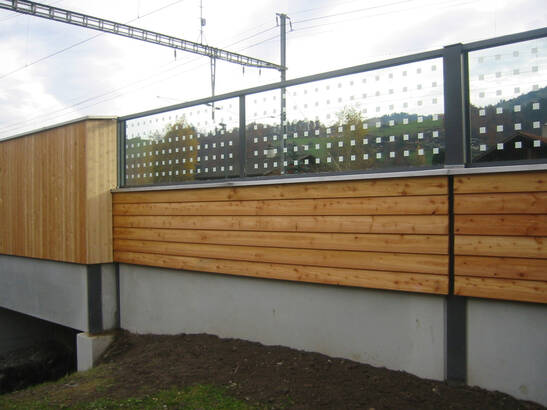
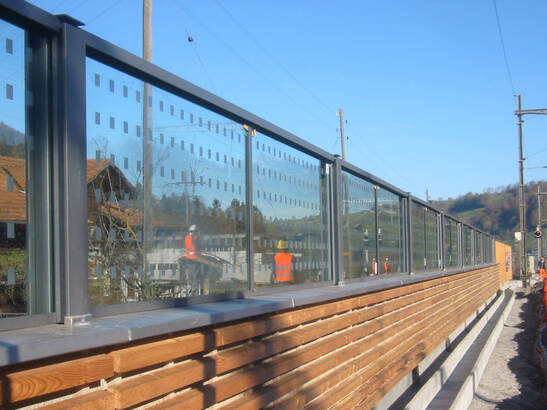
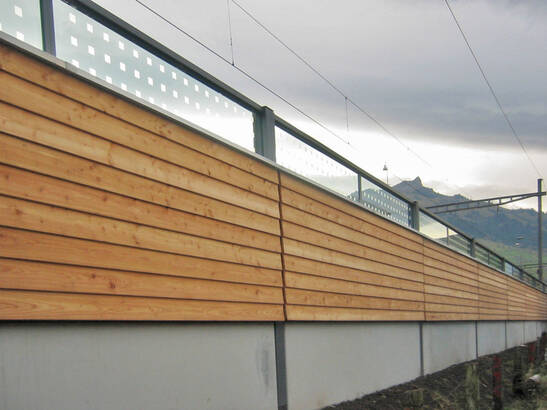
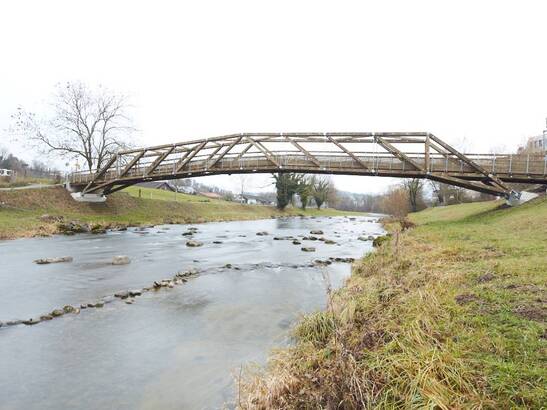
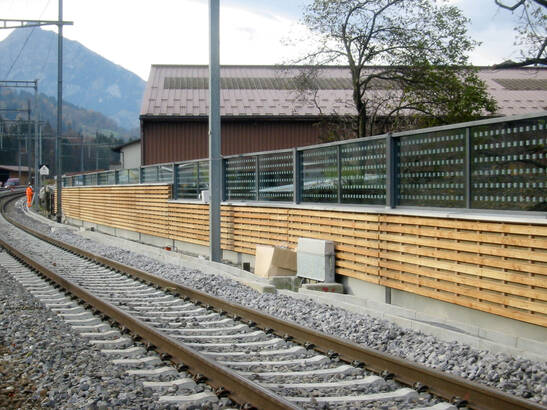





Wildlife bridge Rynetel
Switzerland's first wildlife bridge made of wood
When the deer cross the A1 freeway to mate from summer 2021, they won't notice that they are walking across Switzerland's first wooden wildlife bridge. For them, it is important that their territories beyond the motorway are made accessible again. Because traffic routes cut through the habitats of wild animals, the Federal Office for the Environment defines wildlife corridors of supraregional importance. Conventional wildlife bridges are reinforced concrete structures. They serve the animals, but are anything but climate-friendly. The two environmental aspects can certainly be combined: The "AG6" corridor connects the Jura region with the Mittelland and runs between Gränichen and Suhr over the A1. Here, the 50-meter-wide wooden construction now enables wildlife to cross the highway safely.
Swiss wood
Hüsser Holzleimbau AG in Bremgarten processed around 850 cubic meters of construction timber to manufacture the 156 arched girders. A large glue press pressed the spruce boards into the desired shape until they were dimensionally stable after the RF adhesive had cured.
Over 1000 tons of CO₂ saved
One cubic meter of wood relieves the atmosphere of around one ton of CO₂, because trees convert CO₂ into oxygen and carbon as they grow thanks to photosynthesis. The production of one cubic meter of reinforced concrete, on the other hand, generates around 500 kilograms of CO₂. The construction of the wildlife bridge superstructure in concrete would have caused emissions of 480 metric tons of CO₂ during manufacture, assembly and transport. With the timber variant, only 182 tons of CO₂ were emitted during the production of the glulam and for the manufacture of the steel joints.
At the same time, the wood used stores 775 tons of CO₂ thanks to photosynthesis. Net, 593 tons of CO₂ are stored in the Rynetel wildlife bridge. The difference between the wooden and concrete variants is therefore 1073 tons of CO₂. This corresponds to the emissions of over three million car kilometers. Wood is thus clearly ahead on the climate issue. If we want to achieve the Paris climate targets, we have to do without steel and concrete. The Wild Animal Bridge with its wooden superstructure is a first step in this direction.
Comparison of the greenhouse gas emissions of the timber overburden with a concrete overburden. The overpass structure without foundations and without superstructures was compared on the basis of the preliminary project. Calculation according to KBOB 2009/1:2022. The concrete cover was calculated according to the preliminary project with a cross-sectional area of 28.64 m² and an average length of 73.19 m, thickness at the apex 40 cm. This results in 2400 t of concrete and 144 t of reinforcing steel. The timber cover was calculated as realized with 382 t glulam and 54 t steel joints.
Construction and assembly
The 850 cubic meters of structural timber for the wildlife overpass in Suhr grew in the Swiss forest within 3 hours and 26 minutes, taking into account the type of wood and the offcuts. From this, 156 glulam arches were prefabricated and glued in a dimensionally stable manner.
The girders, each weighing two tons, have a span of 17.4 meters, a cross-section of 24 by 76 centimeters and are mounted on the cast-in-place concrete walls with steel joints.
In the crown area, the construction is thus covered with 70 centimeters of soil and seepage gravel, at the outer walls and the center support (right in the picture) the layer of soil is over 4 meters high!
A two-meter-high glare shield demarcates the bridge. On the side of the bridge, the glare shield is joined with the wildlife fence to prevent animals from entering the highway. The glare shield is an important element that protects against headlights so that the animals can cross the bridge as undisturbed as possible.
The installation of the girders was carried out exclusively in night work. During 24 nights from 9:30 p.m. to 5 a.m., traffic was reduced to one lane in each direction and merged into one lane. This meant that work could be carried out over the other lane in each case. A total closure of the highway was ruled out from the outset.
Wood is the better solution
In the preliminary project phase of the Rynetel wildlife bridge, the client, together with the planning team, compared the designs in concrete and wood. In addition to cost-effectiveness, the structure had to be low-maintenance and durable and last for 100 years. A later expansion of the highway from two to three lanes must be possible, and the flow of traffic on the highway must be able to be guaranteed at all times during the construction period. These requirements are no problem for wood.
Construction data
- Spans: 2 x 17.4 meters
- Length: 35.6 meters (transverse to the roadway)
- Width: 54 meters (longitudinal to the roadway)
- Bridge area: 1'922 m²
- Timber: 850 m³ spruce
- Origin Switzerland
Construction costs
- 13.9 million Swiss francs
Services Timbatec
- SIA Phase 31 Preliminary design
- SIA Phase 32 Construction design
- SIA Phase 41 Tendering and comparison of offers
- SIA Phase 51 Detailed design
- SIA Phase 52 Execution
- SIA Phase 53 Commissioning
- Technical planning fire protection
Client
Federal Roads Office ASTRA
4800 Zofingen
Timber construction
Häring AG
5074 Eiken
Photography
NILS SANDMEIER
2501 Biel/Bienne
Planning
Ingenieurgemeinschaft WUEF;
Bänziger Partner AG, 5400 Baden and
Timbatec Holzbauingenieure
Master builder
Aravia Bau AG
5303 Würenlingen
Glulam supplier
Hüsser Leimbau AG
5620 Bremgarten
Wildlife bridge Neuenkirch
Wildlife bridge from local wood
In Neuenkirch, the Federal Roads Office (FEDRO) built the second wildlife overpass with a wooden cover after the Rynetel wildlife overpass. As with the Rynetel structure, the assembly work in Neuenkirch had to be carried out at night. During ten nights, carpenters assembled the 17.5-meter-long, 1.24-meter-high and 8-ton wooden girders.
Around 2,500 cubic meters, mostly spruce from the Entlebuch region, were used for this purpose. The fact that the wood was cut in the surrounding forests and processed in regional companies is a benefit for the local economy. The environment is also pleased. After all, from an ecological point of view, local wood is clearly more advantageous than wood from abroad.
Construction and assembly
In Neuenkirch, too, the bridge was erected entirely at night to ensure highway operations. During 21 nights, the police diverted traffic to the opposite lane so that the lanes below the overpass could be used for the assembly work.
Compared to the Rynetel overpass, the costly steel components could be greatly reduced. Oak sleepers (yellow) and horizontal contact timbers, also made of oak, lie on the abutments and the central wall in cast-in-place concrete to support the spruce girders, which are 17 meters long and weigh around 8 tons.
The beams made of glulam GL24k are designed as single-span beams with a cant of 10 centimeters. They have dimensions of 720 x 1240 millimeters and are arranged at a skip dimension of around 1.15 meters. The secondary supporting structure consists of 100-millimeter-thick cross laminated timber panels that are fastened directly to the longitudinal girders and serve as a base for the multilayer waterproofing.
In the Neuenkirch structure, too, several layers cover the timber structure for impermeability and root protection. Unlike the Rynetel overpass, the portals could be designed without a parapet. The anti-glare protection was directly included in the portal design and mounted on the parapet.
Anyone traveling on the A2 between Sursee and Lucerne today passes the Wildtierbrücke bridge immediately after the Neuenkirch freeway service station - often without even noticing the materials used to construct the bridge.
Would you like to load this additional content?
This placeholder hides an external resource that has not been loaded due to your cookie settings. Click on the button below to allow this resource.
Construction data
- Width 50 meters
- Length 36 meters
- Clearance height 4.80 meters
- 2500 m³ spruce wood from the region
Construction costs
- BKP 1-9: 10.7 million Swiss francs
- BKP 214: approx. 2.7 million Swiss francs
- Planning fee: 198,000 Swiss francs (as sub-planner of the civil engineer)
Services Timbatec
- SIA phase 31 preliminary project
- SIA phase 32 construction project
- SIA phase 41 invitation to tender and comparison of offers
- SIA phase 51 execution project
- SIA phase 52 execution
- SIA phase 53 commissioning
- structural analysis and design
- cost estimate
- technical site supervision and site inspections
Owner
Federal Roads Office ASTRA
4800 Zofingen
Timber construction engineer
Timbatec Holzbauingenieure (Schweiz) AG Bern
3012 Bern
Timber construction
HUSNER AG Holzbau
5070 Frick
Civil engineer
IG 2B Ingenieurgemeinschaft
3000 Bern 15
GU/TU
Anliker AG
6021 Emmenbrücke
We are convinced that wood as a material will find its way into infrastructure construction because it is the most environmentally friendly option. That is why we are constantly developing new construction solutions with our partners, calculating the statics and ensuring the fire protection of infrastructure buildings. Anyone who wants to make a contribution to climate protection today builds with wood - also in the infrastructure sector.

























